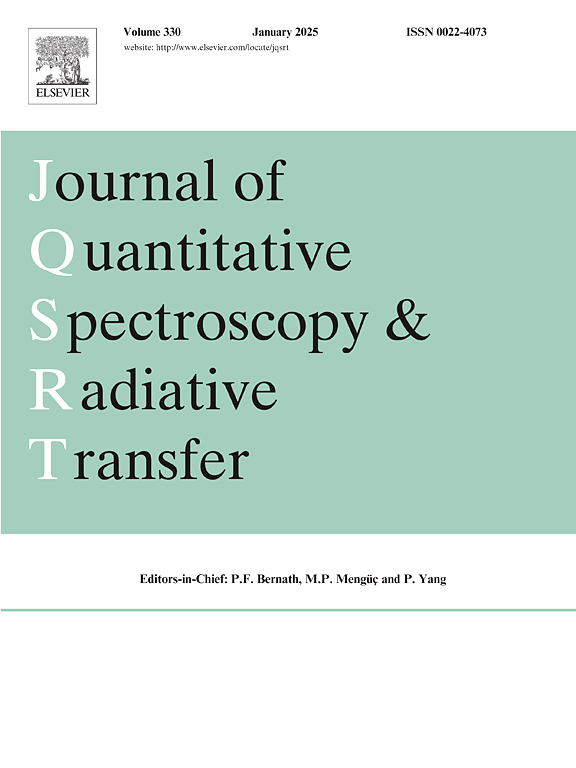Coherent backscattering in discrete random media of particle ensembles
IF 2.3
3区 物理与天体物理
Q2 OPTICS
Journal of Quantitative Spectroscopy & Radiative Transfer
Pub Date : 2024-10-29
DOI:10.1016/j.jqsrt.2024.109226
引用次数: 0
Abstract
We consider radiative transfer and coherent backscattering (RT-CB) in a discrete random medium of particles. The elementary scattering matrix of the medium conforms to the ensemble-averaged scattering matrix for nonspherical particles and their mirror particles, both in random orientation. We express the ensemble-averaged matrix, via spectral decomposition, as a linear superposition of four pure Mueller matrices, and enable RT-CB computations via an independent treatment of the pure matrices. We validate the method for sparsely and densely packed random media of spherical particles. For the case of sparse packing, we compare two different RT-CB approaches, one with explicit input of polydisperse spherical-particle characteristics and the other with input by decomposing the ensemble-averaged scattering matrix. The results are in agreement and reproduce markedly well the asymptotically exact results from the Fast Superposition -Matrix Method (FaSTMM). For the cases of dense packing, we compare the RT-CB to the FaSTMM by invoking the ensemble-averaged incoherent scattering matrix of volume elements as input for the RT-CB. For non-absorbing particles, the RT-CB agrees well with the FaSTMM. For strongly absorbing particles, there are deviations that underscore the need for further method development. In order to demonstrate the potential of the RT-CB, we compute multiple scattering for a sparsely packed spherical medium of nonspherical feldspar particles by utilizing their experimentally measured ensemble-averaged scattering phase matrix. Finally, we discuss future prospects for the RT-CB.
粒子群离散随机介质中的相干反向散射
我们考虑了离散随机粒子介质中的辐射传递和相干反向散射(RT-CB)。介质的基本散射矩阵符合非球形粒子及其镜像粒子的集合平均散射矩阵,两者都处于随机方向。我们通过谱分解将集合平均矩阵表示为四个纯穆勒矩阵的线性叠加,并通过对纯矩阵的独立处理实现 RT-CB 计算。我们对球形粒子的稀疏和密集随机介质进行了验证。对于稀疏堆积的情况,我们比较了两种不同的 RT-CB 方法,一种是明确输入多分散球形粒子特性的方法,另一种是通过分解集合平均散射矩阵输入的方法。这两种方法的结果一致,并很好地再现了快速叠加矩阵法(FaSTMM)的渐近精确结果。在密集堆积的情况下,我们通过调用体积元素的集合平均非相干散射矩阵作为 RT-CB 的输入,将 RT-CB 与 FaSTMM 进行了比较。对于非吸收粒子,RT-CB 与 FaSTMM 非常吻合。而对于强吸收粒子,两者之间存在偏差,这凸显了进一步开发该方法的必要性。为了证明 RT-CB 的潜力,我们利用实验测得的集合平均散射相位矩阵,计算了非球形长石颗粒稀疏球形介质的多重散射。最后,我们讨论了 RT-CB 的未来前景。
本文章由计算机程序翻译,如有差异,请以英文原文为准。
求助全文
约1分钟内获得全文
求助全文
来源期刊
CiteScore
5.30
自引率
21.70%
发文量
273
审稿时长
58 days
期刊介绍:
Papers with the following subject areas are suitable for publication in the Journal of Quantitative Spectroscopy and Radiative Transfer:
- Theoretical and experimental aspects of the spectra of atoms, molecules, ions, and plasmas.
- Spectral lineshape studies including models and computational algorithms.
- Atmospheric spectroscopy.
- Theoretical and experimental aspects of light scattering.
- Application of light scattering in particle characterization and remote sensing.
- Application of light scattering in biological sciences and medicine.
- Radiative transfer in absorbing, emitting, and scattering media.
- Radiative transfer in stochastic media.

 求助内容:
求助内容: 应助结果提醒方式:
应助结果提醒方式:


